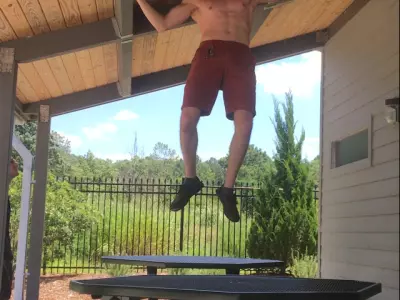How to Train for One-Arm Pullups
A guided path towards completing a calisthenics milestone
One-arm pullups are a key milestone in any calisthenics aficionado’s belt. Beyond their impressive grace and strength, one-arm pullups are also a handy tool for climbers eager to improve their lock-off ability and skill on any strength-based sequence. Like any advanced training technique, reaching the level of strength and control to complete this movement takes dedication and intense training. The following paragraphs will guide you through a series of progressions useful in attaining your goal.
Archer Pullups
Archer Pullups are a great first step for those keen on starting their one-arm pullup training. To complete an archer pullup, start from a deadhang position, just like a normal pullup. From the deadhang, pull yourself towards the bar. Instead of pulling yourself towards the space between your hands, as you normally would when doing a pullup, instead pull yourself towards one of your hands till your chin touches your hand. Lower yourself down and pull yourself towards the other hand.This exercise will begin the process of strengthening the muscles and tendons necessary for a one-arm pullup.
Scapular Pullups (Both dual-arm and one-arm)
Scapular pullups are an essential movement for climbers. To complete a scapular pullup, start from a full deadhang. While keeping your arms straight, bring your shoulders backwards and downwards. This should bring your shoulder-blades closer together and chest towards the bar. From this position, allow yourself to slowly move back down into a deadhang. Once you feel confident completing this exercise with both arms, switch to just one arm. This exercise will strengthen your scapular rotation, essential for the lower portion of a one-arm pullup.
Negatives
Negatives allow an athlete to utilize the exact muscles and tendons used for a one-arm pullup without the strength required for a full rep. To complete a negative, raise yourself up to the bar using both arms. Upon reaching the bar, slowly lower yourself down with just one arm till you reach a dead-hang. This progression should not be attempted until one is able to slowly lower oneself, as dropping down quickly can result in elbow or shoulder injury.
Assisted One-Arm Pullups
Once you have a solid base of strength, assisted pullups are one of the best ways to move from pullups to one-arm pullups. There are three main methods of assistance that can be used: fingers, rope, and resistance-band. Finger-assisted one-arm chins are quite simple in their nature. To complete this progression, the athlete just utilizes less fingers on one of their hands while continuing to use all fingers on the arm they’re training. As an example, the athlete may start out with just using the middle and ring fingers on one hand. As they near the point of being able to do a one-arm pullup, the athlete may drop down to just using their pinky finger to balance. Rope assisted pullups allow the user to mimick the feeling of a one-arm pullup. Tie a rope around the bar and hold the rope with one hand. A pullup is then completed with the other arm, utilizing the rope as little as possible. To make this exercise more difficult, move your hand further down the rope and lighten (or feather) your grip on the rope. Resistance-band assisted pullups are completed in a similar manner to rope assisted pullups with one exception: a resistance band is utilized instead of a rope. To make this exercise more difficult, one can use a lighter weight resistance band.
What Next?
Generally, athletes will be able to achieve a one-arm chin-up (palm facing the body) prior to their first one-arm pullup (palm facing away from the body). Upon acc omplishing your first one-arm chin-up, start adding these into your workout routine while continuing to use assisting means to improve your one-arm pull strength and balance. Accomplishing BOTH of these movements will yield great results for your climbing and overall fitness. See you at the crag!


